Partnerships in the Pandemic Spotlight: Santa Cruz Outdoor Science School
By Cristina Edwards and Emilie Lygren
Heather MacDougall Molloy directs Santa Cruz Outdoor Science School, a residential outdoor science program located in Santa Cruz, CA. She is also an active participant in efforts to develop and implement an environmental literacy plan focused on increasing outdoor learning opportunities for students across Santa Cruz County.
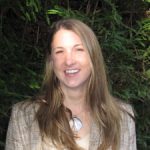 We talked with Heather about a pilot program that offers childcare and outdoor learning to children of school district employees, how they’ve adjusted their safety protocols to be responsive to the needs of students and instructors, and how they plan to expand the program in the future.
We talked with Heather about a pilot program that offers childcare and outdoor learning to children of school district employees, how they’ve adjusted their safety protocols to be responsive to the needs of students and instructors, and how they plan to expand the program in the future.
This interview is part of our Partnerships in the Pandemic series on outdoor, in-person learning.
BEETLES: Please describe the partnership between your organization and the district, school, or classroom you’re partnering with. How did it come about? How did you build this connection with the district? Who is working with students? How is it funded?
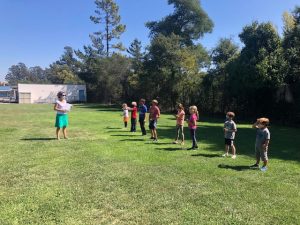 Heather: I work in Santa Cruz County, and Santa Cruz City Schools, the second largest district in the county, was looking for a childcare program for their teachers who have children. They wanted to offer support for those teachers so they could focus on their classroom students. We’d been discussing these Covid outdoor learning initiatives for months. In a meeting with my superintendent, we talked about how we could best use me and our two permanent staff from our outdoor science school since our program has temporarily closed due to Covid. I responded: “We should be in the schoolyards, supporting students outside in learning, using all the PPE and precautions.”
Heather: I work in Santa Cruz County, and Santa Cruz City Schools, the second largest district in the county, was looking for a childcare program for their teachers who have children. They wanted to offer support for those teachers so they could focus on their classroom students. We’d been discussing these Covid outdoor learning initiatives for months. In a meeting with my superintendent, we talked about how we could best use me and our two permanent staff from our outdoor science school since our program has temporarily closed due to Covid. I responded: “We should be in the schoolyards, supporting students outside in learning, using all the PPE and precautions.”
The superintendent had been in conversation with the Community Foundation of Santa Cruz County, and they were able to provide funding for this work. That was an important goal. We want to extend this program to also support students who have parents who aren’t employed, and students who aren’t logging in to virtual learning. We wanted this to be a free program.
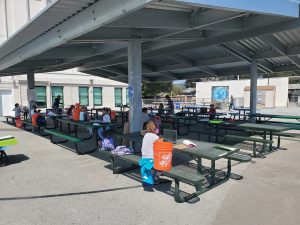 Our goal was to prioritize equity and access to the program. A lot of outdoor education programs in our area have shifted to a model during the pandemic where children meet at an outdoor education program campus, or at a location like a beach or local park. We were really committed to doing this in the schoolyard because that’s where parents are used to bringing their kids. We didn’t want to create another barrier by conducting the program in a location other than their school. We asked the school district to look at outdoor features that were already there in terms of shade, protection from rain, etc., and we identified three campuses that would be the best to start with. The goal was for the students to come onto campus, where they have a desk or picnic table where they can log in to their distance learning. We had a tech person come check the wifi connection ahead of time.
Our goal was to prioritize equity and access to the program. A lot of outdoor education programs in our area have shifted to a model during the pandemic where children meet at an outdoor education program campus, or at a location like a beach or local park. We were really committed to doing this in the schoolyard because that’s where parents are used to bringing their kids. We didn’t want to create another barrier by conducting the program in a location other than their school. We asked the school district to look at outdoor features that were already there in terms of shade, protection from rain, etc., and we identified three campuses that would be the best to start with. The goal was for the students to come onto campus, where they have a desk or picnic table where they can log in to their distance learning. We had a tech person come check the wifi connection ahead of time.
In terms of the structure of the program, one outdoor science instructor, and one district staff person works with each group of 12 students. This opportunity allowed us to re-employ some of our outdoor educators to do this work, and also offered an opportunity for the school district to offer work to employees like recess supervisors, who weren’t working because school wasn’t in session.
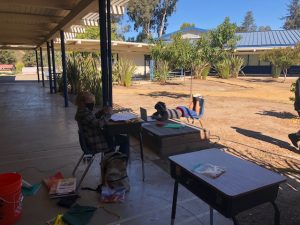 In the morning, students log in to their distance learning and the adults provide support, with things like logging in, or responding to students’ questions. After lunch, the outdoor science school instructors lead STEM and enrichment activities. This includes opportunities for nature connection and exploration, mindfulness, investigation, and observation. The program runs from 7:30am-3:30pm, and takes place entirely outside.
In the morning, students log in to their distance learning and the adults provide support, with things like logging in, or responding to students’ questions. After lunch, the outdoor science school instructors lead STEM and enrichment activities. This includes opportunities for nature connection and exploration, mindfulness, investigation, and observation. The program runs from 7:30am-3:30pm, and takes place entirely outside.
We designed it to be “low drag,” and have few barriers to implement in order to support equity. The program is low in materials. Each student uses a hula hoop, clipboard, and 5-gallon bucket (donated from Home Depot) to keep their materials in. We focused on using outdoor spaces that already existed instead of building new infrastructure.
BEETLES: What are some of the safety procedures and protocols you have in place in the program?
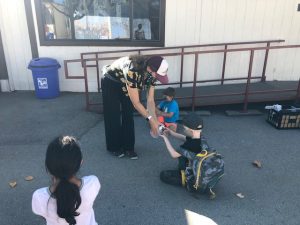 Heather: Masks are required, we have all of our learning stations separated by at least 6 feet and marked with tape or chalk. Students might have a picnic table where they work that is at least 6 feet away from the nearest student. Or, custodians will bring out desks in the morning and take them back inside the afternoon to keep them safe and sanitize them. Every student has their own hand sanitizer. When students use the bathroom, they hand sanitize before going in, and they are instructed to wash hands with soap afterwards. They also have to hand sanitize with an adult present after returning from the bathroom. We started using washable, non-toxic markers to put small dots on each of their fingers before they go to the bathroom, and those dots have to be gone when they return to show they have washed their hands.
Heather: Masks are required, we have all of our learning stations separated by at least 6 feet and marked with tape or chalk. Students might have a picnic table where they work that is at least 6 feet away from the nearest student. Or, custodians will bring out desks in the morning and take them back inside the afternoon to keep them safe and sanitize them. Every student has their own hand sanitizer. When students use the bathroom, they hand sanitize before going in, and they are instructed to wash hands with soap afterwards. They also have to hand sanitize with an adult present after returning from the bathroom. We started using washable, non-toxic markers to put small dots on each of their fingers before they go to the bathroom, and those dots have to be gone when they return to show they have washed their hands.
At least once a day, the custodial staff will spray and sanitize desks and other materials. They do this at the end of the day, and whenever possible throughout the day. Each group is also stable with the same students in each cohort. The families are asked not to enroll their kids in other group activities like sports or childcare or other learning groups.
For lunchtime we have hula hoops that we put out across the schoolyard. Each student gets a hula hoop to sit in and that’s where they can take off their mask and eat. At their learning station where they log in to distance learning, students can also take their mask off because they are more than 6 feet apart. If an instructor comes to support them while they are at the learning station, the student puts the mask back on. We do storytime after lunch, so the younger kids can lay in the grass and listen to the story. During those times, students are also physically separate.
BEETLES: How is it going so far? What have been some successes and challenges that have emerged?
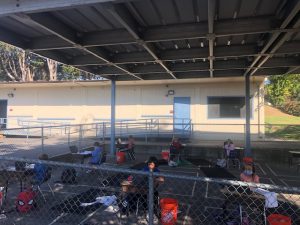 Heather: The mask wearing has been one of the easiest things to enforce. The students really seem to understand this requirement. At one of our sites, a kindergartener student was in his square drinking a juice box, he put his mask on to go three feet away outside of his square to throw it out. We ask parents to bring backup masks, and we have disposable surgical masks available as well. We’re not doing anything special aside from setting that standard at the beginning. We’re also in a community where mask wearing is really embraced, so that might be part of why it has been fairly easy for us.
Heather: The mask wearing has been one of the easiest things to enforce. The students really seem to understand this requirement. At one of our sites, a kindergartener student was in his square drinking a juice box, he put his mask on to go three feet away outside of his square to throw it out. We ask parents to bring backup masks, and we have disposable surgical masks available as well. We’re not doing anything special aside from setting that standard at the beginning. We’re also in a community where mask wearing is really embraced, so that might be part of why it has been fairly easy for us.
The biggest challenge has been enforcing physical distancing during times when students aren’t at a desk or picnic table, or aren’t in physically marked places like their hula hoop during lunchtime. Initially, we said that students were going to be physically distanced at least 6 feet from one another at all times. But this was hard when students were in groups doing outdoor science learning, or having free time on the playground. In the beginning, we would use pool noodles, or have students stretch out their arms and step away from one another to create physical space– but it was challenging because students spread out side-to-side but would still be standing near one another front to back.
In the beginning, this was really challenging. The staff were finding they needed to be militant, focused only on keeping students 6 feet apart when the student is not in a stable station like a hula hoop or desk. There was a lot of frustration. The staff determined it was really impossible to maintain physical distancing during outdoor learning sessions and playground time. It makes sense – kids want to interact.
From there, we knew that we had to respond. Looking at the language in the industry guidance from the California Department of Public Health, it indicates that students are to be physically distanced “when practicable.” So we decided that during meals and at desks, students would be distanced, but we would allow more flexibility during playground/recess time and outdoor learning experiences. Students will always be masked during that time, but not necessarily 6 feet apart the whole time.
We felt like we needed to get out in front of this decision and communicate it officially to the parents, because we’d said we were 100% doing physical distancing, and we needed to be more specific. So we sent a letter to parents, saying that during meals and at desks, students will be distanced. And we told the parents clearly, that students may not be distanced at other points. We wanted them to have this information and allow them to make that choice for themselves in terms of what feels safe.
None of the parents pulled their kids. When you look at all of the other safety measures – having a stable cohort, being 100% outside, consistent mask use, the hand sanitizing, there’s really just that one physical distancing piece. The school principal’s response was that “they’re kids, we have to be reasonable and human.” There wasn’t any backlash about this decision, and our instructors were really relieved.
BEETLES: What are some other challenges and successes you’ve had?
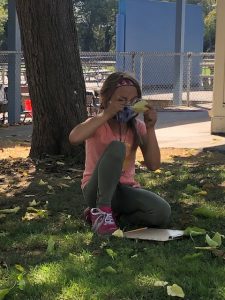 Heather: The biggest challenge for teaching outdoor education in the afternoons is the age span. We have students ranging from TK through 4th grade. The attention span is really different at those different ages. To mitigate this, we encourage flexibility in the teaching. Our instructors have a whole plan of what they’re supposed to teach, and they can pick and choose and adapt in the moment. They know that the goal is giving students a positive experience of outdoor exploration and focused observation. We’ve communicated they don’t need to go lock-step with the curriculum.
Heather: The biggest challenge for teaching outdoor education in the afternoons is the age span. We have students ranging from TK through 4th grade. The attention span is really different at those different ages. To mitigate this, we encourage flexibility in the teaching. Our instructors have a whole plan of what they’re supposed to teach, and they can pick and choose and adapt in the moment. They know that the goal is giving students a positive experience of outdoor exploration and focused observation. We’ve communicated they don’t need to go lock-step with the curriculum.
As for successes, being outside offers exciting learning opportunities. We can have the instructors focus a little more on “what’s happening that’s interesting?” and following student interest. On one rainy day, the students brought umbrellas. During a break, the students started running down a hill with their umbrellas and trying to jump and fly as they got to the bottom. The students were having discussions about whether they felt like they floated, asking questions like, “Do you go actually slower?” The instructors followed students’ interest in this and had really interesting discussions about questions like, “Does air have mass?” In the outdoors, those types of connections can be made from a simple activity.
 We’ve also gotten good feedback in parent surveys. It seems that being outside, seeing trees, buildings, fresh air on your skin, sunshine… it’s all been positive. Even sitting in distance learning outside has been phenomenal, and parents are picking up on this. The students are happier and doing better because they’re outside the whole time. For my experience as a parent with a child in the program, it’s been super positive. My son can be a reticent kid. But since he started the outdoor program, within a week I had heard more about school than I had heard for his entire K-3 career.
We’ve also gotten good feedback in parent surveys. It seems that being outside, seeing trees, buildings, fresh air on your skin, sunshine… it’s all been positive. Even sitting in distance learning outside has been phenomenal, and parents are picking up on this. The students are happier and doing better because they’re outside the whole time. For my experience as a parent with a child in the program, it’s been super positive. My son can be a reticent kid. But since he started the outdoor program, within a week I had heard more about school than I had heard for his entire K-3 career.
The other huge win has been Sit Spots. After storytime, students do Sit Spots, where they find a place to sit alone and be quiet. One week, my son’s group had a substitute teacher and the students didn’t do their Sit Spots as usual. My son came home and was up in arms that he missed it. He can’t quite articulate what it is he likes about it, but when they didn’t happen, he was not okay with it. Every day, five days a week they get to sit quietly or stand and wiggle and have time alone. If things go terribly, there’s always Sit Spots and then some exploration. If students are in a funk, there’s always that. That’s been another huge win.
BEETLES: You’ve shared a little more on how you have considered equity and access in setting up this partnership. Is there anything else you’d like to share about this, and where could you improve in this area?
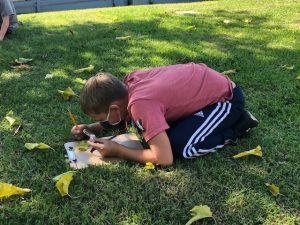 Heather: We’re thinking about expanding to make this happen at more schools. After our program was underway for a few weeks, we were touring campuses around the district with HR and superintendents and principals to find spaces for outdoor learning. In the past few months, the program has grown to bring in newcomers, emerging multilingual students, students with special needs, and students who aren’t logging in to distance learning. We have just under 300 students now, and we’re adding more in December and January. We’re also hoping to expand to other districts within our county, using a model where we provide outdoor education staff and can re-employ more educators.
Heather: We’re thinking about expanding to make this happen at more schools. After our program was underway for a few weeks, we were touring campuses around the district with HR and superintendents and principals to find spaces for outdoor learning. In the past few months, the program has grown to bring in newcomers, emerging multilingual students, students with special needs, and students who aren’t logging in to distance learning. We have just under 300 students now, and we’re adding more in December and January. We’re also hoping to expand to other districts within our county, using a model where we provide outdoor education staff and can re-employ more educators.
We started with children of teachers as a pilot. I wish we could’ve started with the high needs groups, but this approach allowed us to figure it out. It’s wonderful to see momentum for the program to grow.
BEETLES: What are your plans for this collaboration in the future, both in the short term and in the longer term? Would you consider continuing to form these kinds of partnerships when the pandemic “ends” or when schools return permanently to in-person instruction?
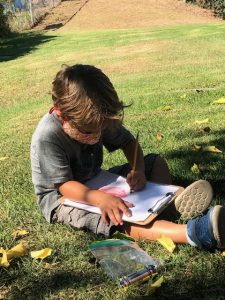 Heather: Before Covid, we already had our outdoor program instructors coming to schools and taking students outside for STEM. We’ve been posing that idea to teachers. I think there is momentum around this at the district level, too. I’ve gotten connected with superintendents that I wouldn’t have had otherwise during this pilot program. There’s a lot of realizations happening at the district level: “We can be outside, it’s a good thing.”
Heather: Before Covid, we already had our outdoor program instructors coming to schools and taking students outside for STEM. We’ve been posing that idea to teachers. I think there is momentum around this at the district level, too. I’ve gotten connected with superintendents that I wouldn’t have had otherwise during this pilot program. There’s a lot of realizations happening at the district level: “We can be outside, it’s a good thing.”
I’m also trying to get surveys from parents that highlight the importance of being outside. It’s not a research study, but the goal is to get some stories. The districts who have taken this opportunity to move kids outside are now more aware of outside as a viable option for learning. That sets the opportunity for us, the County Outdoor Education program and the County Office of Education, to train the teachers to do outdoor learning, or continue to partner to offer these kinds of outdoor education opportunities ourselves. The teachers are interested in teaching outside. In the past, it’s always been the district and superintendent that were hard to move. We hope that now they see that outdoor learning is easy and it’s valuable.
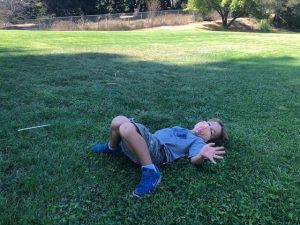 By the Numbers
By the Numbers
- Students served: 64
- Instructors employed: 5
- Incidence of Covid at the time of this interview: none
Read about how other programs are navigating outdoor, in-person learning: Partnerships in the Pandemic.

Leave a Response